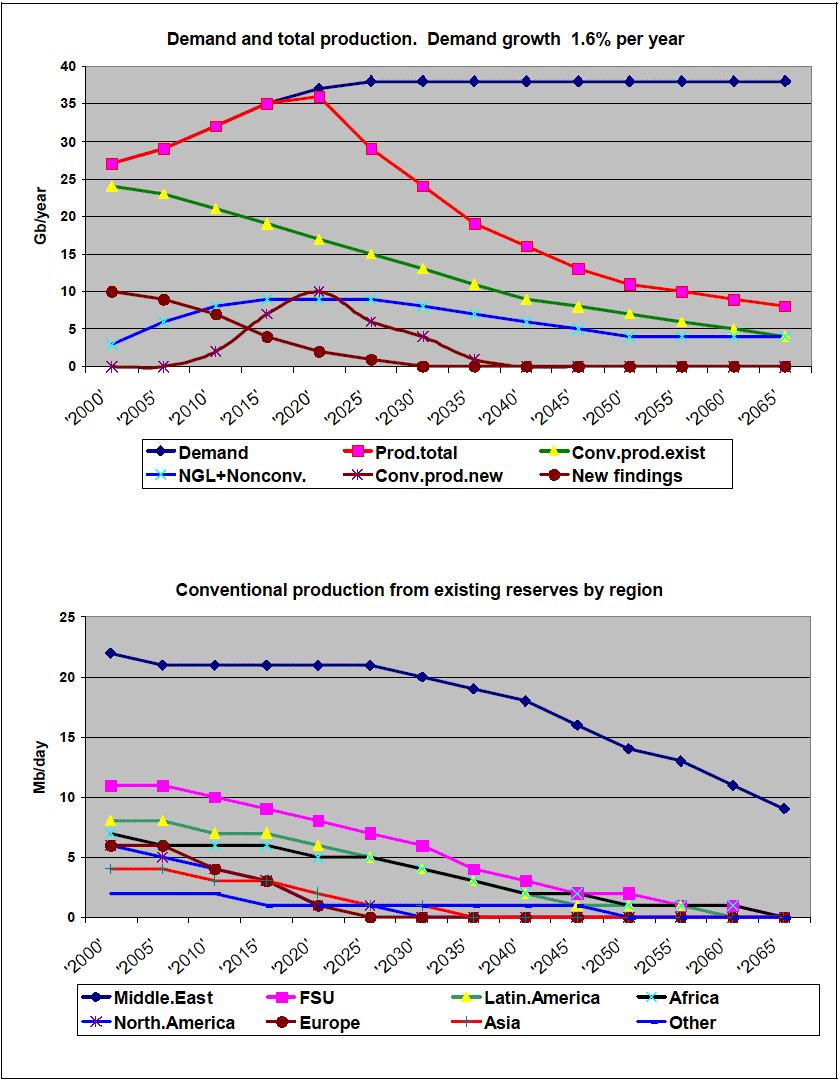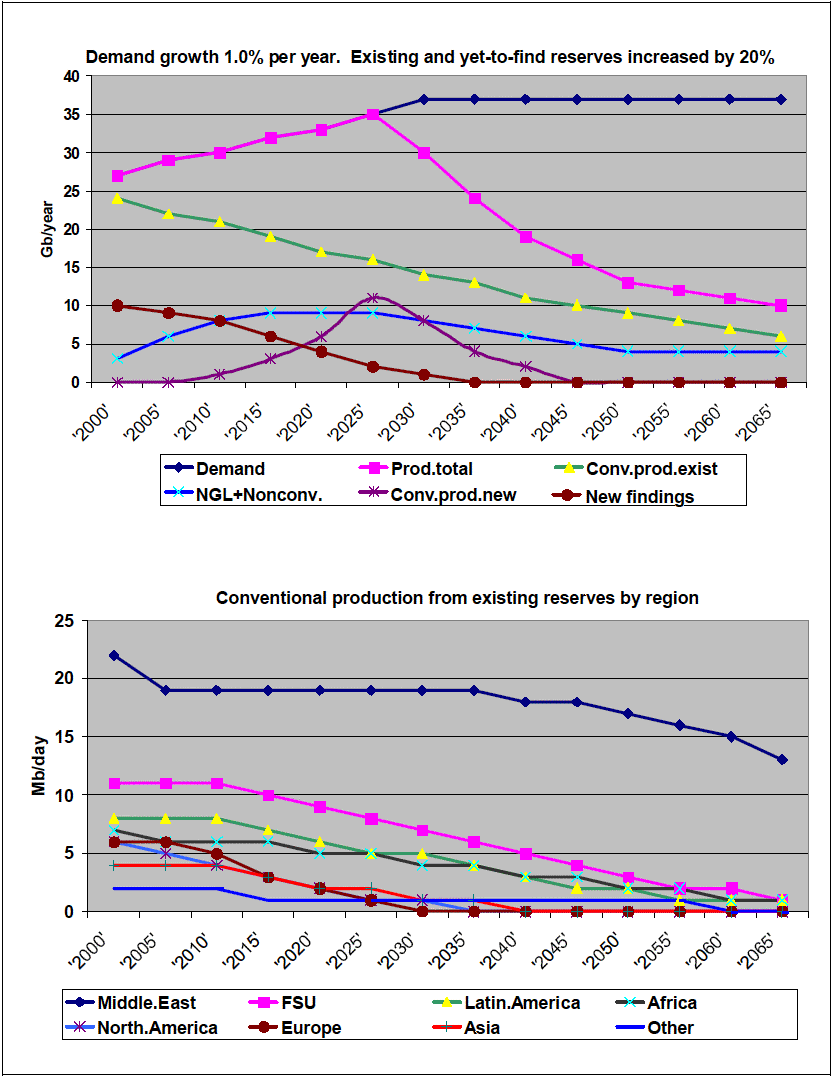The Danish Board of Technology and the
Society of Danish Engineers (2004): Oil-based
Technology and Economy Prospects for the Future: A
short introduction to basic issues and a review of oil depletion
projections derived from different theories and methods. March
2004, The Danish Board of Technology, 103p.
『石油に基づいた技術と経済の将来見通し:基本的問題点の簡単な紹介と、異なる理論と方法から得られた石油枯渇推定のレビュー』
Foreword
Contents
『Preface
The cheap-oil era is a short anomaly in the Earth’s
history.
In the 20th century the production of liquid and gaseous hydrocarbons
from fossil reservoirs
- oil and natural gas - rose towards a peak.
In the 21th century production will be declining.
In the course of a century, technologies based on oil as a unique,
easily handled fuel have
shaped the world, its human habitats, its transportation infrastructures,
its agriculture.
The time available to find substitutes for fossil oil and the
technologies depending on it
is much shorter.1
1The graph above is copied from Kenneth
S. Deffeyes: Hubbert’s Peak - The Impending World Oil Shortage.
Princeton University Press, 2001. (page 6)
From 1900 onward, people have been “crying wolf” when they
had done their R/P arithmetic on conventional oil reserves (R)
and annual oil production (P) and found that the ratio was only
10 years or so. However, as reserves grew at a faster rate than
production, the ratio kept growing, being now about 40 years.
So far, so good. Today no one disagrees that the wolf is out there
but differences in analyses and opinions as to when it will attack
the sheep still prevail. An R/P ratio of 40 years does not mean
that production can be sustained at the present level for 40 years.
Production will peak and begin declining long before the last
barrel has been produced. The question is, when is the peak likely
to occur and how steep is the decline likely to be ?
In recent years several experienced oil geologists and some economists
have sought to draw attention to their analyses of the prospects
for the future supply of cheap, conventional oil, which - according
to their findings - is likely to peak within the next ten or fifteen
years. If demand continues to grow until the production peak occurs,
the following irrevocable decline in production will have grave
social and economic consequences.
Other researchers, notably researchers in the United States Geological
Survey (USGS), which is the governmental body responsible for
oil and gas research in the US, and the US Energy Information
Administration (EIA) refute the validity of these analyses, claiming
that the predictions of an imminent peak in conventional oil production
are unrealistic. Also the OECD’s Paris-based International Energy
Agency (IEA) states in its World Energy Outlook 2002 that supply
can meet demand at least until 2030, provided that very large
investments in exploration and the development of production capacity
and pipelines are made. Similar projections are presented by the
European Commission in the report World energy, technology and
climate policy outlook 2030 (WETO, 2003). However, the IEA explicitly
states its concerns regarding the strenuous actions to be taken
by governments in order to increase production at such a rate
that economic development in the OECD countries as well as in
the transition economies and the developing countries can be sustained.
Any prediction of future demand and production is counterfactual
and, therefore, uncertain. However, the functioning of modern
societies is so heavily dependent on oilbased technologies and,
therefore, on the supply of oil that governments must gain qualified
information about the past and the probable future development
in reserves and production capacities in order to assess the number
of years that may be made available for the substitution of oil-based
technologies before the decline in the supply of oil sets in.
This review draws attention to the technological and economic
characteristics of the brief singular era in the history of the
Earth in which cheap conventional oil has been available in abundant
amounts and presents the perspectives for the prospective ending
of this era as assessed by various researchers who base their
analyses on different methods.
It is recognised that the assessments to be made should not concern
the total geological depositions of oil and other fossil hydrocarbons
from which oil can be extracted or synthesised. Assessments of
these abundant amounts are practically irrelevant for the assessment
of supplies in the next decades. The assessments to be made concern
the volume of the reserves and the production capacities which
can be made available in a foreseeable future at competitive costs
and without unacceptable environmental impacts. Also, governments
should assess the compatibility of the global oil consumption
rate with climate change mitigation policies.
No conclusions are drawn in this review. However, it is found
that the evidence provided from public domain sources, upon which
this review is based, warrants the scrupulous and politically
unbiased assessment of the opportunities to balance global oil
demand and oil production capacity in the next decades and the
consequences of a decline in oil production capacity for the economies
in the affluent countries and the economic development in the
poor regions.
If the time-horizon for the impending peak in the production
of cheap conventional oil is as short as one or two decades or
less, the problems involved in handling the situation are of a
specific, practical nature. Therefore, economic policies should
not rely on general, theoretical assumptions that technological
progress will ensure sufficient supplies of oil or
substitutes for oil. Engineers and oil geologists should assess
the investments in new, more energy-efficient end-use techniques
and new discovery and recovery techniques needed to ensure that
demand peaks before a decline in supply sets in. And economists
should make governments aware of the national and international
economic consequences of a
peak in oil supply for which governments, industries and consumers
are unprepared and spell out economic policy conditions required
for the implementation of the investments needed in end-use and
supply industries in order to mitigate the consequences before
the peak occurs.
The low cost of conventional oil has allowed the development
within a few decades of a world economy which is based on extravagant
and wasteful use of this unique, most valuable fuel and thus depletes
its precious resource base much faster than long-term economic
considerations would justify.
In each chapter of this review the factual evidence referred
to is presented in the form of quotations from articles found
in professional journals; conference proceedings; books written
by prominent authors in the field of oil geology and oil economy;
and reports published by authoritative institutions. This evidence
constitutes the basic substance of the review. It is the subject
matter of the interpretations and discussions offered.
|
Future oil supply is a controversial subject. The professional
discussion is very heated. Not only the media but also
professional journals have set up a verbal boxing ring where
the socalled “pessimists” fight the so-called “optimists” - notions
which suggest that professional judgement in this field is based
on subjective sentiments rather than objective assessments based
on well-documented evidence, theories and methods. This should
be disquieting as the subject matter is of crucial importance
to the world economy. Disagreement between professional analysts
is no excuse for responsible politicians not to examine the evidence
available and take a stand.
The verbal boxing ring is good entertainment in the media. However,
the truth does not reveal itself when a contender takes the count.
Irrespective of human controversies, the truth relentlessly reveals
itself as time goes by. And whether we like it or not, it is
biassed towards the realities of this world. Regarding oil production,
scrupulous research and analysis of the geological, technological,
economic, and political evidence available is the only way to
trace it. No one knows what the future will bring. But men and
women are born to use their intellect to look ahead and pass
warnings from the crow’s nest to the helmsman - so as to avoid
the fate of the Titanic.
From the author’s presentation of this review
at the Copenhagen conference 2003 |
|
“Is the future going to be a rerun of the past ? I don’t
think so. “
“We’ll see an exchange of the cheap and easy with the expensive
and slow.”
Francis Harper at the Copenhagen conference 2003 |
The conventional wisdom of the prevailing economic theories
relies on the axiom that worldwide economic growth of a nature
which implies continued growth in the production and consumption
of energy-consuming hardware can continue for an indefinite length
of time. That market forces will ensure that new resources and
new technologies will always be at hand when access to the resources
upon which our societies depend becomes restrained and present
technologies therefore become obsolete.
History shows that man has hitherto succeeded in making life
easier by means of new energy sources and technologies. From
manpower to horsepower. From horsepower to coal-fired steam engines.
From steam engines to oil-engines. Thus economic development
has, so to speak, been a ride downhill with the wind behind us.
However, there is nothing in sight
which is so easy and cheap to get, handle, store, and to use
in cars, buses, trucks, tractors, ships, and aeroplanes as oil
from oil wells.
Therefore, unless something unknown today turns up or our oil-based
consumer culture takes a turn towards less oil-dependent activities,
we face an arduous ride uphill against a headwind when one day
the supplies of cheap conventional oil become restricted.
History may reveal that the prevailing axiom of sustainable
economic growth is a theoretical derivative of the cheap-oil
era. In contradistinction to economic theory, oil geologists
have voiced concerns about future oil supply. |
』
Summary
Depletion scenarios
The economy and the geological reality of oil supply
Oil and natural gas. Energy costs of oil production
Oil consumption and climate change
The need for international regulation
Transportation
1. The Cheap-oil Era
1.1 The oil-world
1.2 Towards the end of the windfall energy economy
1.3 The aging resource base
2. Oil - the Unique Liquid Fuel
2.1 Conventional oil
2.1.1 Liquid fossil oil deposits
2.1.2 Natural gas liquids (NGL)
2.2 Non-conventional fossil oil
2.2.1 Heavy oil, extra heavy oil, and tar sand
2.2.2 Oil Shale
2.2.3 Synthetic oil from coal and natural gas
2.3 Oil from biomass
2.4 The terms ‘Reserves’ and ‘Resources’
3. Demand and Supply
3.1 The IEA World Energy Outlook 2002 and World Energy Investment
Outlook 2003
3.2 World energy, technology and climate policy outlook 2030
(WETO)
3.3 The higher the rise the steeper the fall
3.4 Options for the reduction of the demand for conventional
oil
3.4.1 Oil demand determinants
3.4.2 Ways and means to restrain the demand for conventional
oil
1) Reduction of inefficient, unnecessary, wasteful or extravagant
use of oil
2) Reduction of the demand for oil by the replacement of oil-based
technologies
3) The substitution of non-conventional fossil oil and oil
from biomass for conventional oil
4. Conventional Oil Reserve Assessments
4.1 Reserve development
4.2 Future discoveries and enhanced recovery techniques
4.3 Ultimate reserve estimates
4.3.1 Laherrere’s estimates
4.3.2 Campbell’s estimates
4.3.3 USGS’s probabilistic assessments
4.3.4 The WETO POLES model
5. Oil Demand and Reserve Depletion Scenarios
5.1 Demand and supply
5.2 Hubbert depletion scenarios
5.3 Campbell’s depletion scenario
5.4 EIA’s R/P based depletion scenarios
5.5 OILPROSPECTS scenarios
6. On the Economy of Oil
6.1 On the economy of the cheap-oil technology complex
6.1.1 Motorcars
6.1.2 Speed
6.1.3 Trucking
6.2 On the new economy of oil supply
6.3 Administering a market with low marginal production costs
6.4 Market experiments with the global economy

Figure 5.8 Demand and production scenario computed from
the data shown in the box above and a 1.6% demand growth until
2030. In this example, it is assumed that production from existing
reserves in a region begins to decline when 50% of the ultimate
reserves in the region has been produced.

Figure 5.9 Demand and production scenario resulting from
a 20% increase of remaining reserves (2000) and new findings
as compared to the values given in the box above and a reduction
in demand growth to 1%. |
戻る

